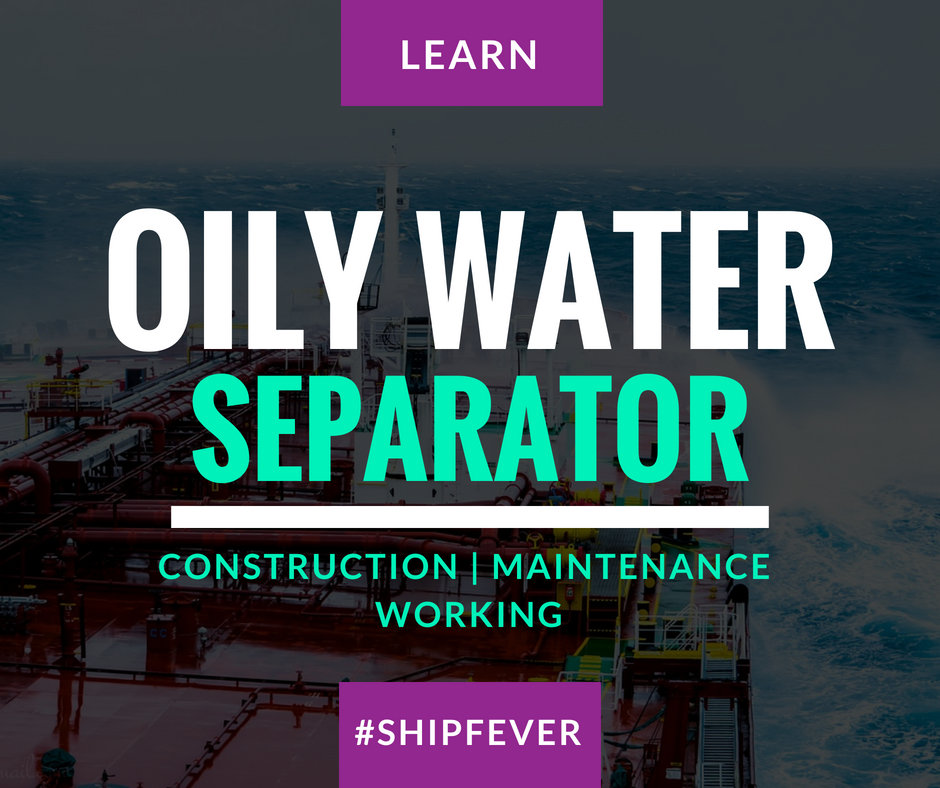Last Updated on June 16, 2018 by Arpit Singh
Among all machinery Oily Water Separator ( OWS ) is given a unique status because of it function and penalties that may imposed because of its irregularities to the ship owner/manager and criminal punishment to seafarer under whose duty Oily water separator comes.
As Oily Water Separator is the result of MARPOL 73/78, Annex 1-hip produce water and oil on daily basis because of many factors such as leakage of fresh water pipeline, sea water pipeline, leakage from gland packing / sealing, accidental leakage within engine room, etc. Oily bilge water is the mixture of water, oily fluids, lubricants and grease, cleaning fluids and other wastes that accumulate in the lowest part of a vessel from a variety of sources. The mixture of oil and water is to be separated and dirty oil is to be discharged out of the ship by using equipment such as Oily water separator ( OWS ).
As the name suggest oily water separator is a piece of machinery that separate oil from water, As per maritime regulations, the oil content in the water processed from the OWS must be less than 15 parts per million of oil.
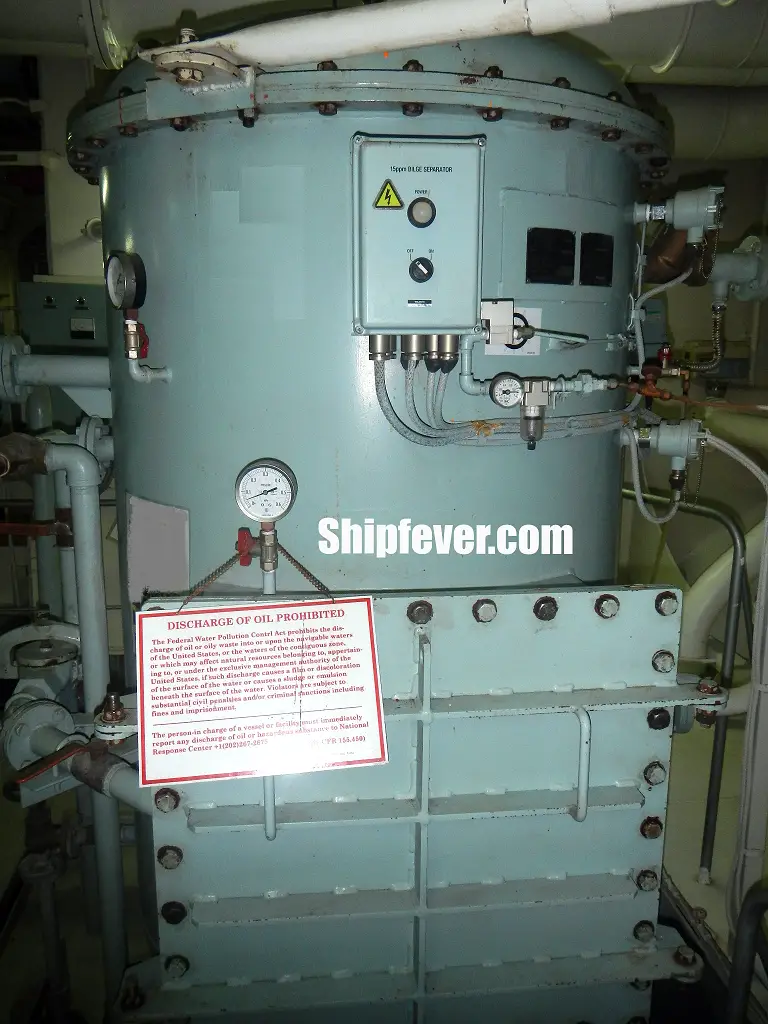
Essential requirements for Oily Water separator
- All parts design for the oily water separator is required to be approved by the authority or administration.
- Approving authority must ensure that the oily water separator pass through the minimum discharge limit of 15 ppm.
- Additional alarms and sensors must be installed on the equipment where it can’t be monitored and maintained at all time.
- Arrangement must be made so the machine automatically cut off discharge beyond above limit.
- Any discharge of oily mixture is prohibited in sea unless the ship is in route and is discharged through an oily water separator.
- Oil record book must be maintained on each discharge on tank to tank basis.
Construction
The construction of oily water separator is simple with three main parts; separator, filter and control unit with no such moving parts. The whole arrangement is separated into two compartment one for the separator and the other for filter. A separator unit consists of course separator with catch or baffles plates to accumulate small oil particles; with different parts such as test cock, collection chamber, drain, oil heater ( electric and steam ), riser pipe and separating sheet to assist in this process.
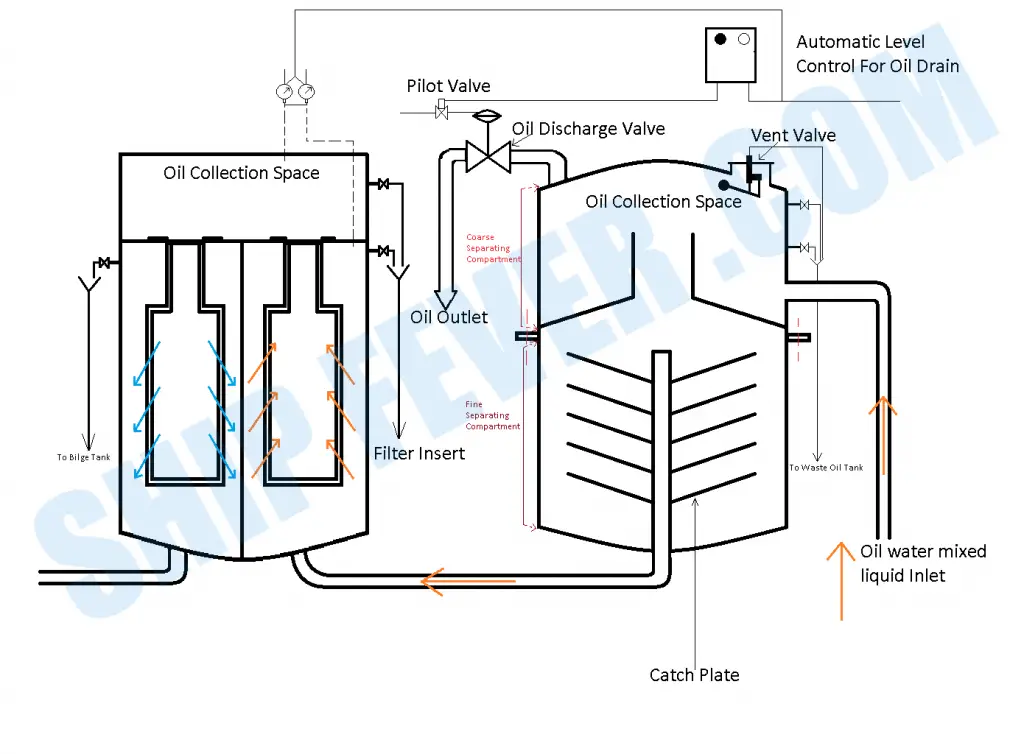
The other compartment with filtering unit then filters and remove these accumulated oils from the separator. The unit consists of two or three stage coalescer filters; where the impurities separated is then later removed manually. On other hand a control unit consists of two separate monitoring and control device. They consists of a mixing pump, test chamber, light source and a controller with inputs from discharge rate, ship speed and oil content.
Working Principle of An Oily Water Separator

1. Separating Unit
From the above diagram one can see how simple and easy it is to understand the working of a O.W.S. The whole process of O.W.S starts with pumping bilge water to the first / separator chamber via bilge pump. The baffles plate in the first chamber increase the separating area by providing additional surface to the oil particles to accumulate and form large oil particle. These large and slow oil molecule can now move to the surface quickly.
After sufficient amount of large oil molecule collected on the water surface; right hand side valve is opened to remove the accumulated oils on the surface. These oil practice is sent to the waste oil tank / oily bilge tank from the separation stage of the O.W.S. Once the oil is removed the valve shuts automatically.
Different specific gravity between oil and water can be further exploited in the first chamber by using laminar or steam line flow; as turbulent flow can cause further emulsification. In separation chamber the oil content in bilge water is only reduced to 100 ppm; so sent to second stage to meet 15 ppm requirement.
2. Filtering and Control Unit
In filtration or second stage of oily water separator ( O.W.S ) the oily mixture is further filtered using coalescer mechanism. These filters absorbs the oil molecules following upward in first stage of filtering unit and moving downward during the second stage. The coalescer filter along with subsequent sponge like material having low surface area and lower pressure loss; provide final water content with less than 15 ppm oil.
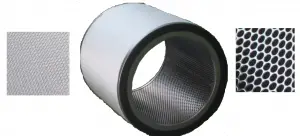
Even after filtration the water can’t be directly released into the sea. Instead it is passed through O.C.M ( Oil Content Monitor ) which detect and ensure the oil content is below 15 ppm. If the oil content in the water is more than 15 ppm than it gives an alarm with water output automatically diverted to the bilge tank through a three way valve preventing sea pollution. If everything is within required limit the water is discharged overboard through the same three way valve.
Factors Affecting Separation Of Oil From Bilge Water
- Density: A liquid with less density than of other tends to rise up; water have generally more density than that of oil so its easy to separate them if left untouched or at low flow rate.
- Effective Density Difference: We know that the density of sea water is more that of the fresh water and so; we can increase the rate of rate of separation by using sea water instead of fresh water.
- Viscosity of Continues Fluid: This law is contradictory to the above statement as it states; a less dense fluid with less viscosity offers better condition for oil to move towards the surface than of a much dense fluid with more viscosity. In other words the rate of rise of oil particles is inversely proportional to viscosity of the fluid. here the viscosity of fresh water is less than that of sea water.
- Temperature: The temperature of the fluid is an major factor that affects both density and its viscosity. At low temperature there is more viscosity among fluid particles restricting separation; but with increase in temperature the mixture became easy to separate even with the same procedure.
- Size of Oil particles: Separation of oil from water is directly proportional to the size of oil particles. Thus to assist in formation of large oil particles in Oily Water Separator we use baffles and stream line flow to reduce further emulsification.
(Schematic diagram) O.W.S of different Construct :
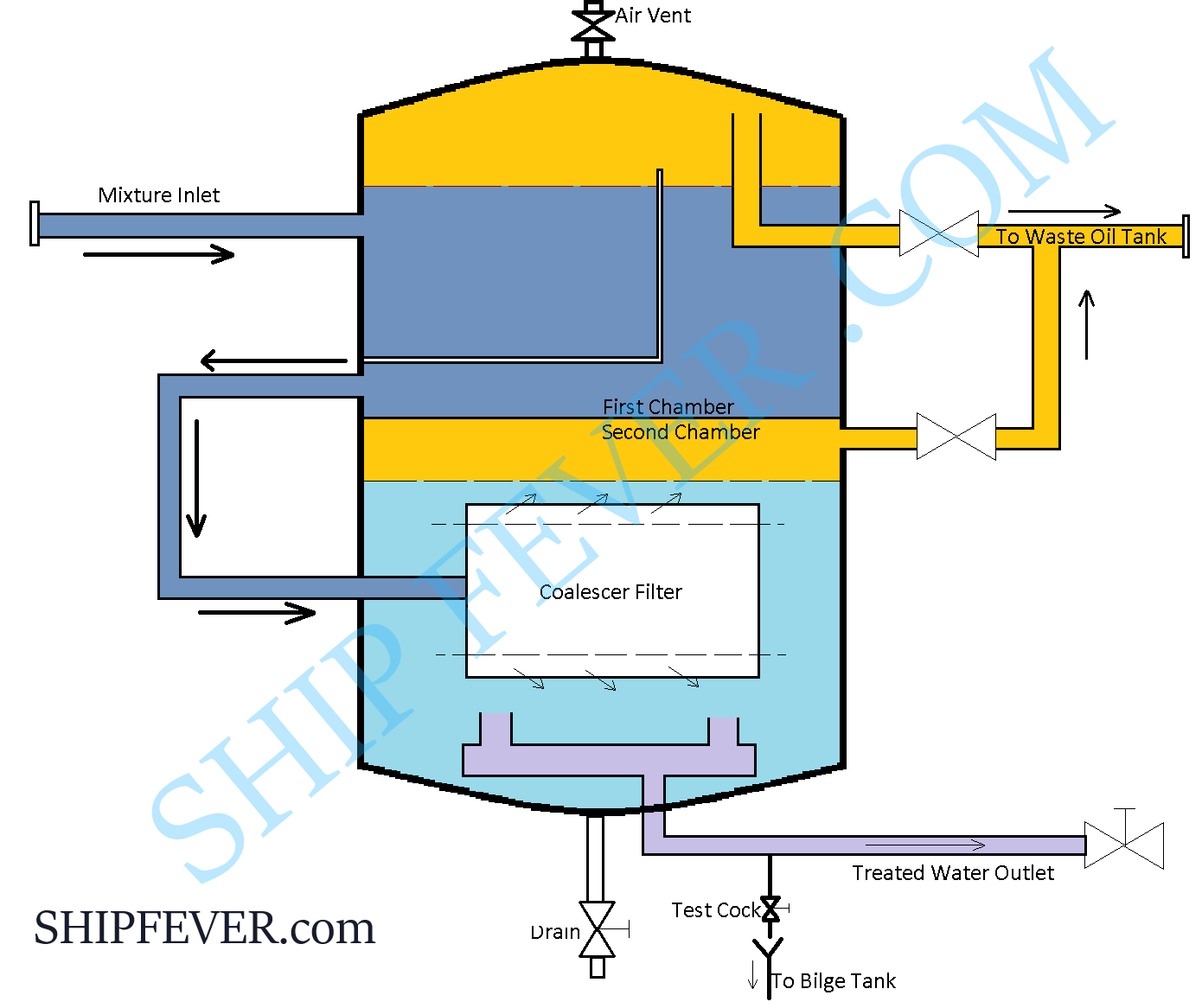
Oil Water Separator Maintenance Checklist
Oily water separator are among the few machinery on board ship which require much less maintenance; thanks to less number of moving parts which are generally the main source of wear and tear. But still it require few maintenance under periodic maintenance on ship; which include changing oil absorbent filters, regular cleaning and monitoring of all units of an O.W.S.
Actually an O.W.S is required to be cleaned once the sludge content reach 25% of the separator compartment or the O.W.S reach 75% of its retention capacity. Along with this all associated valves must also be checked and cleaned regularly. Records must be maintained of such events in form of log book for each maintenance, inspection, date time and amount of residue removed with their mode of disposal.
Certain checklist are made to assist in these paper work which is also refereed as O.W.S Maintenance / Inspection Checklist which include:
- Sediments and debris accumulation.
- Inlet Condition ( Possible blockage or debris accumulation at inlet is checked ).
- Condition of Oil absorbing filter.
- Amount of sediments, sludge and trash in the system.
- Possible spill or leak in recent past.
- Structural condition at outlet.
- Emergency discharge ( If any ).
- Recent maintenance ( parts )
- Inspection day ( If applicable )
- Inspector Name ( If applicable )
Note: The actual document can change from ship to ship but may contain similar / same points.
Dismantling Procedure For Cleaning Oily Water Separator
- Stop the O.W.S Bilge pump
- Stop the flow of steam to the heating coils
- Shut main overboard valve
- Open vent for both separation and filtration chamber.
- Now slowly open drain valve of each chamber located at the bottom.
- Possible oil trapped must be drained to the bildge holding tank.
- Remove all electric and pipe connections.
- Open all the nuts and bolts of the top cover of separation chamber.
- take out the baffle plates and clean them with brush and clean oil.
- Now open all the nuts and bolts of the top cover for filtration chamber.
- Take out the coalescer filters and inspect for its condition.
- Replace the filters if necessary.
- Keep back the baffle plates in place
- Put back the new / cleaned filter in its place.
- Now assemble the whole system.
- Fill the O.W.S with fresh clean water to check for any leakage.
- Ready To Use
Also Read:
- Difference Between Impulse And Reaction Turbine
- Local Regulation For Marine Pollution in Malacca Strait
- Define Centrifugal Casting? Its Types, Working and Application
- What’s the need to change Injection Timing? – Variable Injection Timing
- Effects Of Poor Residual Fuel On Marine Diesel Engine?

